10 Must-See Masterpieces of Ancient Greek Art
Artemision Bronze (5th century BC)
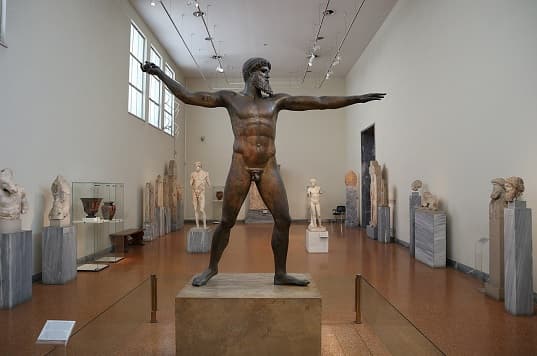
The Artemision Bronze is an ancient Greek sculpture that was found in the sea off Cape Artemision, in northern Euboea, Greece. It is believed to represent either Zeus or Poseidon, two of the most powerful gods in Greek mythology. The statue stands at over 2 meters tall and would have held a thunderbolt if it was Zeus or a trident if it was Poseidon. The statue's sculptor is unknown, and scholars continue to debate its true identity. The sculpture's head is now considered an iconic symbol of ancient Greek culture and has been featured on postage stamps and banknotes. The statue is on display at the National Archaeological Museum of Athens and is considered one of its most significant treasures.
Vix Krater (6th century BC)

The Vix krater is an ancient Greek artifact that is considered one of the most important and impressive finds from the early Celtic world. It is a large, elaborately decorated bronze vessel that was likely used for mixing wine and water, and was found in a burial site in Vix, France. The krater is over 5 feet tall, weighs more than 450 pounds, and is adorned with intricate designs and motifs, including images of hoplites, chariots, and Gorgon heads. It was likely made by skilled Greek craftsmen in the Late Archaic period, but its presence in a Celtic burial suggests that it was either acquired through trade or commissioned by wealthy Celtic patrons who were influenced by the artistic and cultural practices of the Greek world.
Discobolus (5th Century BC)

The Discobolus is one of the most famous examples of ancient Greek sculpture. Also known as the Discus Thrower, this statue depicts an athlete in the act of throwing a discus. The work is believed to have been created around 460-450 BC by the sculptor Myron. The original bronze statue is now lost, but many copies exist, including full-scale marble versions and smaller bronze versions. The statue's muscular form and lifelike pose exemplify the ideal of physical beauty in ancient Greek culture, which placed a high value on athletic prowess and physical perfection.
Laocoön and His Sons (circa 2nd century BC)
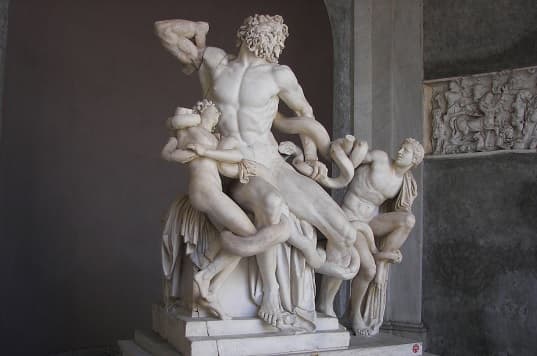
The statue of Laocoön and His Sons, also known as the Laocoön Group, is a famous ancient sculpture that depicts the Trojan priest Laocoön and his two sons being attacked by sea serpents. The statue is considered one of the finest examples of the Hellenistic baroque style and is renowned for its portrayal of human agony. The figures in the statue are nearly life-sized, and the entire group measures just over 2 meters in height. The sculpture is believed to be the work of three Greek sculptors from the island of Rhodes: Agesander, Athenodoros, and Polydorus. The exact origin of the statue is uncertain, but it is thought to date from the Julio-Claudian period (27 BC to 68 AD) and was possibly commissioned for a wealthy Roman's home. Today, the Laocoön Group is on display at the Vatican Museums in Rome.
Alexander Mosaic (4th century BC)

The Alexander Mosaic is a stunning piece of art that depicts a battle scene between Alexander the Great and King Darius III of Persia. Although it is referred to as a "Roman" mosaic, it is believed to be a copy of a Hellenistic Greek painting from the 4th century BC. The scene is incredibly detailed and intricate, with soldiers and horses depicted in various stages of battle. The colors are vibrant and the composition is dynamic, capturing the intensity and chaos of the battle.
Dipylon Amphora (8th century BC)

The Dipylon Amphora is an ancient Greek ceramic vessel that was created around 750 BCE. The vase is named after the Dipylon cemetery in Athens, where it was discovered. It is considered to be one of the finest examples of geometric style pottery from the Greek Dark Ages. The amphora is decorated with intricate geometric patterns that cover its entire surface, and its handles are shaped like human figures. The most distinctive feature of the Dipylon Amphora is the scene on its front side, which depicts a funeral procession.
Venus de Milo (2nd century BC)
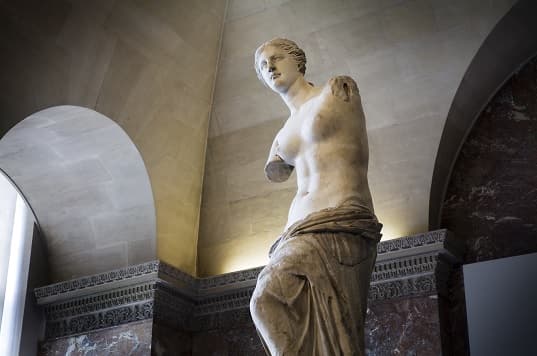
The Venus de Milo is an ancient Greek sculpture that is considered one of the most famous works of ancient Greek art. The sculpture is believed to depict Aphrodite, the Greek goddess of love, and is made of Parian marble. The statue is larger than life-size, standing at 6 feet 8 inches tall, and is missing both arms, with part of one arm and the original plinth being lost after the statue's rediscovery. It was created during the Hellenistic period, sometime between 150 and 125 BC, by a Greek sculptor named Alexandros of Antioch. The Venus de Milo was discovered on the island of Milos, Greece in 1820 and has since been prominently displayed at the Louvre Museum. Today, the Venus de Milo is one of the most famous works of art in the world.
Sphinx of Naxos (6th century BC)

The Sphinx of Naxos is a remarkable statue from Ancient Greece, dating back to the 6th century BCE. It is a large marble sculpture of a mythical creature, the sphinx, which has the head of a woman, the body of a lioness, and wings made of the feathers of a prey bird turned upward. The statue stood on a towering column next to the Temple of Apollo in Delphi, a religious center of ancient Greece. The Sphinx of Naxos is notable for its impressive size, intricate details, and lifelike appearance. It was created by unknown Naxian sculptors and is considered one of their finest works. Despite its age, the Sphinx of Naxos continues to captivate and inspire visitors with its enigmatic smile and powerful presence.
Charioteer of Delphi (5th century BC)
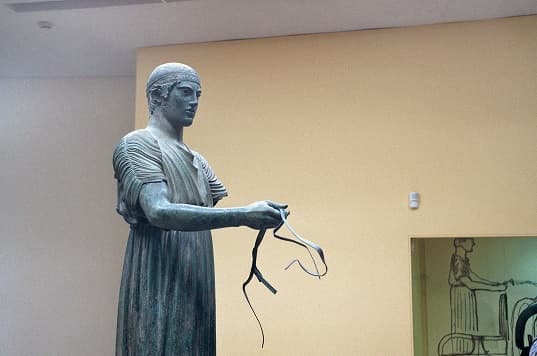
The Charioteer of Delphi is a famous ancient Greek bronze statue that was discovered in 1896 at the Sanctuary of Apollo in Delphi, Greece. The life-size statue depicts a chariot driver, also known as Heniokhos, who was originally part of a larger group of statuary that included at least four horses and possibly two grooms. The statue was set up to commemorate one of the victories of the tyrant Polyzalus of Gela in the Pythian Games of either 478 or 474 BC, which were held at Delphi in honor of Pythean Apollo. Stylistically, the Charioteer is classed as "Early Classical" or "Severe" and is considered a masterpiece of ancient Greek art due to its naturalistic rendering and intricate details, such as the inlaid glass eyes. Today, the statue can be seen in the Delphi Archaeological Museum.
Parthenon Frieze (5th century BC)
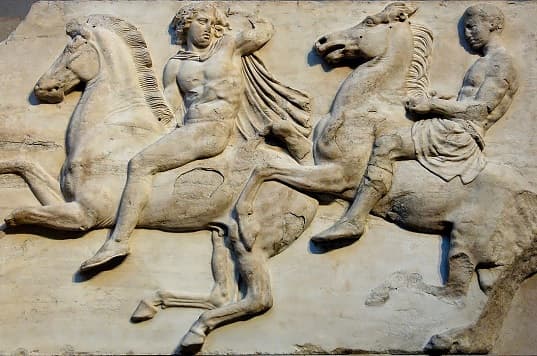
The Parthenon Frieze is a remarkable piece of ancient Greek art that was created in the 5th century BC. It is a sculptural relief that was originally part of the Parthenon temple in Athens, Greece. The frieze depicts a procession of people, animals, and mythological creatures, and it was originally situated on the inner wall of the Parthenon's colonnade. The Parthenon Frieze is significant not only for its beauty and intricate detail, but also for its historical and cultural significance. It provides us with important insights into the religious and political beliefs of ancient Greece, and it is considered to be one of the greatest examples of classical art.
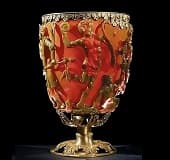
10 Ancient Roman Art Pieces You Can't Miss
Explore these 10 must-see Roman art pieces and discover the beauty of a bygone era.
Explore Now